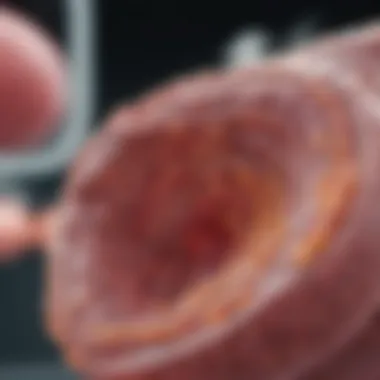Innovative Treatment Approaches for Colon Adenocarcinoma


Article Overview
Moderately differentiated adenocarcinoma of the colon, while just a specific cancer type, represents a complex interplay of cellular structures and treatment options. As the landscape of oncological therapies evolves, the necessity for an informed understanding of various treatment approaches becomes clear. This article explores avenues for treatment, covering surgical methods, the latest in chemotherapy protocols, targeted therapies, and the essence of personalized medicine in improving outcomes.
Summary of Key Findings
- Surgical interventions remain a cornerstone in the management of moderately differentiated colon adenocarcinoma, especially in earlier stages.
- Chemotherapeutic regimens have advanced, with some combinations showing promise in extending survival rates.
- Targeted therapy, though still emerging, offers potentially significant benefits, particularly for patients with specific genetic markers.
- The concept of personalized medicine has reshaped approaches to treatment, emphasizing tailored therapies that align more closely with individual patient profiles.
Research Objectives
The main aim of this analysis is to provide a granular overview of effective treatment modalities for this cancer type. Further, it highlights the critical role of multidisciplinary teams in enhancing patient care and outcomes. Understanding these dynamics can pave the way for better clinical practices and foster the continued evolution of research in this field.
Key Results and Discussions
Main Findings
The investigation into treatment strategies illustrates that a one-size-fits-all approach is increasingly inadequate. The variability in treatment efficacy can be attributed not only to the biological behavior of the tumor but also to patient-specific factors. Here are the significant findings:
- Surgical Interventions: The role of surgery is paramount, particularly in patients whose cancer is localized. Techniques such as laparoscopic resections have become common, promoting faster recovery.
- Chemotherapy and Targeted Therapy: Classic chemotherapy drugs like 5-fluorouracil remain in use, but their combination with newer agents like oxaliplatin has shown improved response rates. Targeted therapies are coming into play, utilizing agents that specifically attack cancerous cells while sparing healthy ones.
- Personalized Medicine: There's a movement toward genetic profiling of tumors. Studies have found that knowing a patient's specific mutations can guide therapy choices, making treatment much more effective.
Implications of Findings
The implications of these findings are profound. These treatment approaches continue to evolve, reminding healthcare professionals of the need for ongoing education and adaptation. As research progresses, the emergence of novel therapies and strategies not only enhances patient outcomes but also reinforces the importance of a holistic approach to cancer treatment, advocating for a dialogue among oncologists, surgeons, and researchers.
"The fight against moderately differentiated adenocarcinoma of the colon is as much about the patient’s personal journey as it is about scientific advancements in treatment."
Preamble to Moderately Differentiated Adenocarcinoma of the Colon
When it comes to understanding colon cancer, specifically moderately differentiated adenocarcinoma, the dialogue is often tangled with complex medical terminologies and statistics that may bewilder even seasoned professionals. Yet, the significance of this specific classification warrants focused attention. Moderately differentiated adenocarcinoma situates itself as a midpoint on the scale of cancer differentiation, playing a critical role in shaping both diagnosis and treatment protocols. Grasping its characteristics and behavior is paramount for effective patient management and therapy customization.
The importance of diving into this subject lies not just in clinical terms but also in surrounding patients and their families. By elucidating the nuances of moderately differentiated adenocarcinoma, we pave the path for informed decision-making. Patients often grapple with uncertainty, and providing clarity through detailed descriptions aids in alleviating some of this burden.
Moreover, as medicine evolves, understanding the definition and characteristics of this cancer type becomes essential. It allows health practitioners to choose appropriate interventions based on how the disease presents itself and its impact on organ functions.
Consequently, the relevance of this exploration stretches beyond mere academic interest. It embodies the ongoing struggle against a prevalent health concern that affects millions globally. Thus, this article delves into the various facets of moderately differentiated adenocarcinoma, aiming to enlighten both students and researchers, as well as educators and professionals in the healthcare industry.
Definition and Characteristics
Moderately differentiated adenocarcinoma of the colon refers to a type of colorectal cancer where the cancer cells exhibit characteristics that are intermediate between well-differentiated and poorly differentiated tumors. In practical terms, this means that the cells retain some features of normal glandular cells, but with enough deviations to raise concern. The overall appearance of these cells under a microscope is significant for classification purposes, as it signals how aggressively the cancer may behave.
Characteristics of moderately differentiated adenocarcinoma typically include:
- Cell Structure: These cells show a reasonable degree of cellular organization and can still form gland-like structures, though they appear abnormal.
- Growth Pattern: This type of tumor generally exhibits a more aggressive growth pattern than well-differentiated forms but may not be as aggressive as poorly differentiated adenocarcinoma.
- Clinical Behavior: The moderately differentiated variant often leads to a spread that can be detected at the time of diagnosis, necessitating a keen focus on staging and treatment choices.
Epidemiology and Risk Factors
The epidemiological landscape of moderately differentiated adenocarcinoma reveals a complex interplay of genetic, lifestyle, and environmental factors. It is crucial to acknowledge these elements to comprehensively understand incidence rates and to push forward preventative strategies.
Several key risk factors associated with this type of cancer include:
- Age: The probability of developing colon cancer, including its moderately differentiated form, increases markedly with age, especially in individuals over 50.
- Diet: A diet high in red meats and processed foods, while low in fiber, has been linked to a higher risk of colorectal cancers.
- Genetic Predispositions: Conditions like familial adenomatous polyposis or Lynch syndrome significantly raise cancer susceptibility.
- Lifestyle Choices: Sedentary habits, along with tobacco and alcohol use, further contribute to cancer progression.
In the broader scope, understanding these epidemiological trends serves not only to inform clinical practice but also contributes vital data for research.
Pathophysiology
Grasping the pathophysiology behind moderately differentiated adenocarcinoma of the colon involves looking into the biological mechanisms that fuel its development and progression. This cancer type generally arises from the epithelial cells lining the colon after prolonged exposure to factors such as inflammation or toxic agents.
The transformation from normal to cancerous cells starts through a series of genetic changes. Common alterations often include mutations in oncogenes and tumor suppressor genes. Some notable genetic alterations could include:
- KRAS mutations: Frequently found in colorectal cancers, altering the signaling pathways that control cell proliferation.
- p53 mutations: These affect the cell cycle and DNA repair mechanisms, contributing to the accumulation of genetic abnormalities.
As the disease progresses, it not only affects the local architecture of the colon but also poses a risk of metastasis, where cells spread to nearby lymph nodes or distant organs, further complicating patient outcomes.
In summary, a thorough understanding of the definition, characteristics, epidemiology, and pathophysiology of moderately differentiated adenocarcinoma of the colon lays the groundwork for improved diagnosis and treatment strategies. Further exploration of its surgical and chemotherapeutic options will provide vital insights into the management of this disease.
Diagnosis of Moderately Differentiated Adenocarcinoma
Diagnosing moderately differentiated adenocarcinoma of the colon stands as a cornerstone in effective treatment planning. This section emphasizes the significance of early and accurate diagnosis, extensive methodologies used, and the consequences of misdiagnosis on patient outcomes. From clinical presentations to imaging techniques and histological evaluations, understanding these aspects can greatly influence management strategies.
Clinical Presentation and Symptoms
Patients afflicted with moderately differentiated adenocarcinoma often exhibit a spectrum of symptoms. It’s crucial to recognize these signs promptly to facilitate timely intervention. Commonly reported symptoms include:
- Abdominal pain: This may be persistent and sometimes worsens after eating.
- Changes in bowel habits: This can manifest as diarrhea, constipation, or alternating between the two.
- Weight loss: Unintentional weight loss should not be overlooked, as it can indicate underlying malignancies.
- Fatigue: Persistent tiredness can result from the body’s battle against cancer.
In some cases, patients experience rectal bleeding or the presence of blood in stools. The connection between colon cancer symptoms and other gastrointestinal disorders is often complex. Therefore, clinicians must maintain a high index of suspicion, particularly in patients with risk factors such as age, family history, or inflammatory bowel disease. Early recognition can be lifesaving, leading to more favorable outcomes.
Diagnostic Imaging Techniques
Several imaging modalities contribute to the diagnosis of moderately differentiated adenocarcinoma of the colon. Each technique plays a distinct role in the evaluation process:


- Colonoscopy: This is the gold standard method, allowing for direct visualization of the colon. It enables not only the detection of tumors but also the collection of biopsy samples for histological examination.
- CT scans: These are utilized for staging the cancer and identifying metastases. It provides a clearer view of surrounding structures and the extent of the disease.
- MRI: Particularly useful in certain cases, MRI can offer detailed images of soft tissues, helping in the evaluation of peritoneal and rectal invasion.
The choice of imaging technique often depends on the clinical scenario, availability, and the patient’s overall health. Combining these methods enhances the accuracy of diagnosis and assists in tailoring treatment modalities effectively.
Histological Examination
A definitive diagnosis of moderately differentiated adenocarcinoma hinges on the histological examination of biopsy samples obtained during procedures like colonoscopy. The assessment involves studying tissue samples under a microscope to identify the cancer’s characteristics. Important aspects include:
- Tumor grading: Moderately differentiated adenocarcinoma typically exhibits a balance between well-differentiated and poorly differentiated features. Pathologists classify tumors based on how closely they resemble normal tissues.
- Morphological features: Elements such as gland formation, cell arrangement, and mitotic activity provide essential insights into tumor behavior and prognosis.
The examination of histological criteria not only aids in diagnosing but also plays a pivotal role in predicting treatment responses.
Overall, accurate histological assessment informs the multidisciplinary oncology team about the most suitable therapeutic approaches, enhancing personalized treatment plans tailored to the patient’s specific cancer type and grade.
In summary, a coherent understanding of the diagnosis process for moderately differentiated adenocarcinoma of the colon underscores its complexity and multifaceted nature. With proper attention to symptoms, advanced imaging techniques, and meticulous histological analysis, healthcare providers can offer patients the best chance for successful treatment.
Surgical Treatment Options
Surgical options stand at the forefront of the treatment strategy for moderately differentiated adenocarcinoma of the colon. The significance of this approach cannot be understated as it often serves as the initial line of defense against tumor progression. Surgical intervention essentially aims to remove the cancerous tissue while striving to maintain as much functionality as possible within the affected organ. This not only plays a crucial role in potentially curative circumstances but also sets the stage for additional therapies—such as chemotherapy or radiation—to follow, ensuring that all angles are covered in tackling this malignancy.
Diverse factors come into play when discussing surgical treatment. These include the tumor’s size, location, and whether it has metastasized. Surgeons often rely on imaging studies and histopathological evidence to determine the most effective course of action. In many cases, the balance between radical removal of cancerous tissues and preservation of critical bodily functions must be carefully navigated. Surgical options typically entail resection techniques, with choices between laparoscopic and open surgeries being pivotal.
Resection Techniques
Resection techniques involve the excision of the tumor along with a margin of surrounding healthy tissue. The precision of these techniques is crucial in achieving clear surgical margins—meaning no cancerous cells are left at the edges of the excised sample.
Several types of resections are prominent:
- Partial Colectomy: This procedure removes a portion of the colon where the cancer resides, including the nearby lymph nodes.
- Total Colectomy: In some cases, a complete removal of the colon might be necessary, especially if the cancer presents extensive infiltration or multifocality.
One key aspect of resection is the staging of cancer. This influences whether a simple excision is sufficient or if larger sections of the bowel need to be taken out. Once the biological dynamics of the tumor are well understood—from growth patterns to metastatic potential—strategies can be better tailored to the individual patient.
Laparoscopic vs. Open Surgery
When it comes to laparoscopic versus open surgery, each method carries its own unique set of advantages and considerations.
- Laparoscopic Surgery: Often referred to as minimally invasive surgery, this technique employs small incisions and specialized instruments. The recovery time associated with laparoscopic procedures tends to be shorter, often resulting in less postoperative pain and quicker return to daily activities. Patients frequently experience less blood loss and a lower risk of infection. However, not every tumor's characteristics make it suitable for this technique; the tumor's size and geographic location might necessitate a more traditional approach.
- Open Surgery: This method involves larger incisions to allow surgeons direct access to the organs involved. While it might come with a longer recovery period, it often offers comprehensive visualization, facilitating the examination and removal of complex or larger tumors. Some factors, such as a patient’s overall health and the tumor’s extent, heavily influence the choice between these two methodologies.
Both strategies work towards the shared goal of tumor excision, but careful patient evaluation and surgical discretion are paramount in this decision-making process.
Postoperative Care and Considerations
Postoperative care is just as vital as the surgical procedure itself. Proper management following surgery greatly impacts recovery and overall patient outcomes.
- Monitoring for Complications: Patients must be observed for potential complications such as bleeding, infection, or bowel obstruction. Early detection can often mitigate these risks.
- Nutritional Support: After surgery, especially if a significant resection has occurred, nutritional adjustments may be necessary. A dietician’s input can help formulate an eating plan that suits the patient's altered digestive needs, ensuring both comfort and nourishment.
- Pain Management: Effective pain control is crucial in aiding a smooth recovery. While medications should be regulated, the aim should always be to keep patients comfortable as they heal.
Furthermore, regular follow-ups and appropriate surveillance imaging to monitor for recurrence can make a significant difference.
"Surgical resection not only offers the potential for curative intent but also informs subsequent treatment decisions."
In summary, surgical intervention remains a linchpin in combating moderately differentiated adenocarcinoma of the colon. The thoughtful application of various resection techniques, along with a careful balance of postoperative care, can vastly improve outcomes, making it imperative that surgical options be tailored to each individual's battle against this disease.
Chemotherapy Regimens
Chemotherapy plays a pivotal role in the treatment landscape of moderately differentiated adenocarcinoma of the colon. As a fundamental component of the multidisciplinary approach to cancer treatment, chemotherapy regimens are designed to target rapidly dividing cancer cells, aiming to reduce tumor size, manage symptoms, and, ideally, extend patients’ survival. The very nature of colon cancer, with its potential to metastasize, necessitates a thorough understanding of the beneficial strategies and potential drawbacks associated with these treatments.
Adjuvant Chemotherapy Protocols
Following the surgical resection of tumors, adjuvant chemotherapy aims to eliminate any residual microscopic disease. Patients receiving adjuvant treatment generally fall into two categories: those at a high risk of recurrence and those who may benefit from the synergistic effects of chemotherapy in combination with surgery.
Common adjuvant regimens include 5-fluorouracil combined with leucovorin, often followed by the addition of oxaliplatin, known as FOLFOX. Studies suggest that this combination can enhance response rates and survival outcomes. This regimen has become a standard, yet evolving with clinical trials investigating the efficacy of newer agents such as oxaliplatin and irinotecan.
Certain considerations must be noted when tailoring therapy for individuals. Factors such as patient age, overall health, and genetic markers—like microsatellite instability—can significantly influence treatment decisions. The goal remains clear: to maximize therapeutic effect while minimizing potential side effects.
Neoadjuvant Chemotherapy Strategies
In some cases, neoadjuvant chemotherapy may be given before surgical intervention, particularly in locally advanced cases. The rationale here is to shrink tumors, potentially allowing for less extensive surgical procedures. This approach can be quite beneficial for bulky lesions that are otherwise difficult to resect.
Common neoadjuvant protocols might mirror those of adjuvant approaches. For example, administering FOLFOX or FOLFIRI can facilitate tumor reduction prior to surgery. The studies have shown that patients might experience improved surgical outcomes following neoadjuvant therapy, as it can sometimes facilitate clear margins, crucial in effective disease management.
However, the implementation of neoadjuvant treatment isn’t universally applicable. Each patient's clinical situation must be evaluated to establish the advantages of this strategy versus postponing surgery. Coordination among the medical team is vital to ensure the best outcome.
Common Chemotherapeutic Agents
A suite of chemotherapeutic agents is utilized in managing moderately differentiated adenocarcinoma of the colon. Understanding these agents is important for both physicians and patients alike.
- 5-Fluorouracil (5-FU): This is often considered the cornerstone of chemotherapy for colon cancer. It functions by inhibiting thymidylate synthase, crucial for DNA synthesis.
- Leucovorin: This agent is frequently combined with 5-FU to enhance its efficacy. It’s not just an additive; it plays a role in maximizing the tumor response.
- Oxaliplatin: Known for its ability to interfere with DNA repair, oxaliplatin is typically used in conjunction with both adjuvant and neoadjuvant protocols.
- Irinotecan: Offering an alternative mechanism, this agent is often employed in cases of relapse or resistant disease. It targets topoisomerase I, another key player in DNA replication.
Each of these agents comes with its share of side effects, from nausea and fatigue to more serious complications. Just as important as the treatment itself is managing the consequent adverse effects, ensuring patient comfort and adherence to the treatment plan.
Each patient's journey is different. Selecting the right chemotherapy regimen requires a personalized approach, considering the distinct characteristics of both the cancer and the individual.


Targeted Therapy Approaches
Targeted therapy has become a pivotal element in the treatment landscape for moderately differentiated adenocarcinoma of the colon. Unlike traditional therapies that attack all rapidly dividing cells indiscriminately, targeted treatments hone in on specific molecular targets that are involved in cancer growth and progression. This precision offers several advantages, making treatment not only more effective but often less taxing on the patient.
The importance of targeted therapies cannot be overstated. They allow for tailored treatment plans based on individual tumor characteristics. This customization is particularly significant as moderately differentiated adenocarcinomas can exhibit heterogeneity in their molecular profiles. Therefore, discerning the right target can significantly improve patient outcomes. Moreover, the side effects associated with these therapies can be less severe compared to those of conventional chemotherapeutic agents, which often come with a laundry list of adverse effects.
Overview of Targeted Agents
Several agents fall under the umbrella of targeted therapy for this type of colon cancer. Notably, monoclonal antibodies such as cetuximab and panitumumab are utilized primarily in patients whose tumors express epidermal growth factor receptor (EGFR). These agents work by binding to the receptor, blocking the signaling pathways that tumors rely on for proliferation.
Another class of agents includes tyrosine kinase inhibitors like regorafenib and ramucirumab. These drugs target specific pathways, inhibiting tumor vascularization and ultimately impeding growth. Both the mechanism of action and the specificity of these agents emphasize the shifting paradigms in treatment—a move toward individualized care.
Additionally, there are emerging agents that are still in the investigational stages, which aim to explore other pathways relevant to tumor growth - highlighting a constantly evolving field ripe for discovery.
Clinical Trials and Efficacy
The efficacy of targeted therapies has been demonstrated in various clinical trials. These studies provide critical insights into how well these agents perform relative to standard treatments. For instance, trials investigating the use of cetuximab combined with traditional chemotherapy have often highlighted improvements in overall survival rates for specific patient subsets, especially when starting treatment earlier in the disease process.
Moreover, the landscape of clinical trials is robust, with new investigations assessing the effectiveness of combining these therapies with immunotherapy. This dual approach aims to enhance the overall immune response against the tumor, possibly leading to better patient outcomes.
Nonetheless, the complexity of targeted treatment necessitates a careful selection process. Factors such as genetic profiling of a patient's tumor can determine the most appropriate targeted agent. The emergence of biomarker screenings adds another layer of precision, ensuring that patients receive treatments best suited for their unique cancer profiles.
"Targeted therapies represent not just a trend in oncology, but a significant shift toward more sophisticated and precise approaches to cancer treatment."
In summary, targeted therapy is reshaping how moderately differentiated adenocarcinoma of the colon is treated. Employing specific agents with well-defined mechanisms, along with ongoing clinical trials, fosters a hopeful landscape for patients navigating this challenging diagnosis. The integration of personalized medicine into treatment plans further solidifies the path toward outcomes that are not just better but are tailored specifically to each individual.
Radiation Therapy in Treatment
Radiation therapy plays a pivotal role in the treatment landscape for moderately differentiated adenocarcinoma of the colon. It isn’t the first line of defense, but it steps in where other methods may fall short, especially in unresectable cases or when there’s a high risk of local recurrence. This section explores the nuances of radiation therapy, digging deeper into its indications and the latest innovations that make this treatment approach more effective.
Indications for Radiation Use
In the context of moderately differentiated adenocarcinoma of the colon, radiation therapy is used primarily in the following situations:
- Preoperative Treatment: Often, radiation is used before surgery to shrink tumors and increase the ease of surgical resection. This approach can improve outcomes and reduce complications.
- Postoperative Treatment: After surgical resection, radiation may be prescribed to eliminate residual cancer cells and reduce the risk of local recurrence, especially if the cancer is staged as greater than T3 or there are positive margins noted during surgery.
- Symptomatic Relief: In cases of advanced disease, radiation can provide relief from symptoms such as pain or bleeding, improving the quality of life for patients.
- Palliative Care: For patients with metastatic disease or those who are not candidates for curative treatments, radiation therapy can help control symptoms and improve comfort.
"The integration of radiation into the treatment plan should always be individualized, based on tumor characteristics and patient history."
Techniques and Innovations
Advancements in radiation therapy techniques have significantly enhanced the efficacy and precision of treatment, minimizing side effects. Some of the notable innovations include:
- Intensity-Modulated Radiation Therapy (IMRT): This sophisticated technique delivers high doses of radiation while sparing healthy surrounding tissues. It allows for precise targeting of the tumor, resulting in fewer side effects.
- Stereotactic Body Radiation Therapy (SBRT): This method focuses high doses of radiation beams with great accuracy, often in fewer sessions. It’s particularly useful for small tumors within the colon that may be difficult to target using traditional methods.
- Image-Guided Radiation Therapy (IGRT): Incorporating advanced imaging techniques enhances the precision of daily radiation delivery, ensuring that the treatment aligns accurately with the tumor's position, which may vary from day to day.
- Combination with Targeted Therapies: New research is looking at the synergistic effects of combining radiation therapy with targeted therapies, enhancing the destructive effects of treatment on cancer cells without increasing harm to normal cells.
These innovations not only improve the outcomes for patients undergoing treatment for moderately differentiated adenocarcinoma of the colon but also cater to a more personalized medicine approach. Evaluating the effectiveness and optimizing therapy regimens continue to be key focuses in ongoing research.
Multidisciplinary Approach to Treatment
In addressing moderately differentiated adenocarcinoma of the colon, a multidisciplinary approach is not just beneficial, it is essential. This method embraces various healthcare specialties, each contributing their expertise to optimize patient outcomes. Engaging specialists from different fields ensures that each aspect of a patient’s care is considered, from diagnosis through treatment and beyond.
The core elements of this approach include the integration of surgical oncology, medical oncology, radiation oncology, and supportive care services. Each team member plays a vital role; for instance, while surgeons focus on physical tumor removal, medical oncologists manage systemic therapies like chemotherapy. This collaboration creates a comprehensive strategy that improves not only treatment effectiveness but also enhances overall patient well-being.
"A team-based approach not only elevates the standard of care but also harnesses diverse insights that can lead to innovative treatment pathways."
Role of Oncology Teams
Oncology teams converge to form a cohesive unit aimed at delivering the best patient care. These teams typically consist of surgeons, nurses, radiation oncologists, pathologists, and pharmacists, among others. Their role is not only about executing treatments but also about engaging with the patient and their family, providing education about the disease process and the treatment pathways available. Communicating clinical findings and treatment options can demystify the experience and empower patients.
Different specialties contribute varying perspectives, ensuring a thorough analysis of each case. For instance, pathologists identify tumor markers that can influence treatment choices, while surgeons discuss potential resection options based on tumor staging. Regular case discussions among team members facilitate shared decision-making and innovation in treatment plans. Consequently, this enhances the acceptance and adherence of patients to their prescribed therapies, which can significantly affect outcomes.
Patient-Centered Care Models
At the heart of the multidisciplinary approach is the emphasis on patient-centered care models. This concept places the patient’s preferences and values at the forefront of treatment planning. It encourages open discussion about individual circumstances, making the treatment process not just about the illness but also about how the illness affects the patient’s life.
Such models encourage the incorporation of psychosocial support services, addressing the mental and emotional toll that cancer treatment can deliver. Integrated care programs often include social workers, dietitians, and psychologists who help manage not just clinical symptoms but also the psychological impacts.
Moreover, patient-centered care promotes the use of personalized medicine, tailoring treatment strategies based on specific biomarkers or genetic profiles, which has shown to yield better results. This approach recognizes that each cancer journey is unique and thus requires a care plan adapted to individual needs.
End
Utilizing a multidisciplinary approach in treating moderately differentiated adenocarcinoma of the colon facilitates a holistic care model. It combines advanced treatments and compassionate support that ensures patients navigate their journey with as much dignity and strength as possible.
Emerging Therapies and Research
The landscape of treatment for moderately differentiated adenocarcinoma of the colon is rapidly evolving. Emerging therapies and ongoing research play a crucial role in enhancing treatment efficacy and tailoring it to individual patient needs. As healthcare professionals and researchers continue to explore novel approaches, the goal remains clear: improving patient outcomes. A notable aspect of these advancements is their potential to address the limitations often associated with conventional therapies.
Research into investigational drugs and specialized treatments can provide avenues for patients who may not respond well to standard chemotherapy or targeted agents. This is important, as every patient’s cancer journey is distinct, and finding effective options is vital in the pursuit of optimal care.
Investigational Drugs and Trials
In recent years, numerous investigational drugs have entered clinical trials, aiming to offer new hope for patients grappling with this formidable disease. Such drugs include novel immunotherapies and small molecule inhibitors designed to selectively target cancer cells, minimizing collateral damage to healthy tissues. Clinical trials are the backbone of determining these treatments' safety and efficacy. Patients who enroll can access cutting-edge therapies that might otherwise remain unavailable.


Key areas of focus in these trials include:
- Novel Immune Checkpoint Inhibitors: Designed to enhance the immune system's ability to recognize and destroy cancer cells.
- Targeted Therapies: Specific agents that target molecular pathways distinct in cancer cells, potentially leading to improved outcomes and lower side effects.
- Combination Therapies: Exploring the effectiveness of combining traditional chemotherapeutic agents with newer investigational drugs, potentially yielding synergistic effects.
Engaging in these clinical trials not only provides access to new treatments but also contributes to the collective understanding of the disease, paving the way for future innovations.
Biomarkers and Personalized Medicine
The integration of biomarkers into treatment strategies is reshaping how moderately differentiated adenocarcinoma of the colon is approached. Biomarkers are biological molecules that indicate the state of cancer and can help guide treatment choices. In personalized medicine, these biomarkers are pivotal for determining which therapies may be most effective for individual patients.
Some key aspects include:
- Predicting Treatment Response: Certain biomarkers can predict how well a patient will respond to specific chemotherapeutic agents, enabling more precise treatment planning.
- Understanding Tumor Biology: Insights gained from biomarker studies can reveal critical tumor characteristics, allowing oncologists to tailor therapies more accurately.
- Monitoring Disease Progression: Biomarkers can serve as indicators for treatment effectiveness or disease recurrence, providing physicians with vital information for adjusting treatment plans.
Implementing personalized medicine not only seeks to enhance patient outcomes but also aims to reduce potential side effects by ensuring appropriate therapies are administered.
"Emerging therapies and research hold the promise of transforming treatment landscapes, offering hope where traditional methods may fall short."
Quality of Life Considerations
Quality of life (QoL) plays a vital role in the journey of patients battling moderately differentiated adenocarcinoma of the colon. Traditional cancer treatments often come with an array of challenges, not only physically but also psychologically. It's essential to recognize that achieving a favorable therapeutic outcome goes hand-in-hand with enhancing the overall well-being of the patient.
Some specific elements contributing to quality of life in this context include:
- Symptom Management: Effective handling of symptoms such as pain, fatigue, and nausea is crucial. Unmanaged symptoms can severely impact day-to-day activities leading to diminished morale and hope.
- Psychological Support: The emotional toll of a cancer diagnosis can't be understated. Supporting mental health is just as important as addressing physical symptoms. Counseling, either individually or in groups, can help patients cope with fear or anxiety related to diagnosis and treatment.
- Social Support Systems: Encourage patients to maintain connections to friends and family. Isolation may compound the struggles they face. Social networks often provide critical emotional and practical support.
- Lifestyle Considerations: Nutritional guidelines tailored to the individual's needs post-diagnosis can also enhance QoL. An appropriate diet not only supports physical health but can boost mood and resilience.
- Palliative Care: Integration of palliative care throughout treatment focuses on relieving symptoms and stress from serious illnesses. It provides an extra layer of support, often contributing positively to the patient's quality of life.
By emphasizing these aspects, healthcare professionals can work not just towards controlling the disease, but also enriching the quality of life for their patients, making each moment and interaction count.
Management of Symptoms and Side Effects
Effectively managing symptoms and side effects is paramount in improving the quality of life for individuals undergoing treatment for moderately differentiated adenocarcinoma of the colon. With chemotherapy, targeted therapies, or post-surgical recovery, patients often experience a spectrum of discomforts:
- Common Side Effects
- Nausea and Vomiting
- Fatigue
- Diarrhea or Constipation
- Pain
These side effects can lead to a range of other issues, including loss of appetite, weight fluctuations, and decreased energy levels making daily life more challenging.
Utilizing a multi-faceted approach can help:
- Medications: Anti-nausea medications, prescribed anxiolytics for anxiety, or pain management protocols can significantly reduce discomfort.
- Lifestyle Adjustments: Simple changes, such as smaller meals, staying hydrated, and incorporating gentle physical activities, can alleviate some symptoms.
- Relaxation Techniques: Practices like meditation or yoga can empower patients to feel more in control of their experience.
The aim is to tailor management plans to the individual needs of patients, enabling them to lead as normal a life as possible.
Supportive Resources and Palliative Care
Supportive resources and palliative care come into play as crucial allies in the treatment journey of colon cancer patients. These services help tackle not only the immediate physical aspects of the disease but also contribute toward emotional and practical support.
Key Components of Supportive Care include:
- Counseling Services: Access to psychological support helps patients navigate the complex emotions associated with a cancer diagnosis. Licensed professionals can provide coping strategies to handle stress and fear.
- Palliative Care Teams: These teams work alongside oncologists to ensure that any pain or other distressing symptoms are adequately managed throughout all phases of treatment.
- Nutritional Support: Registered dietitians can create individualized meal plans considering the patient's preferences, treatment side effects, and nutritional needs.
- Support Groups: Connecting with others in similar situations can foster a sense of community, reducing feelings of isolation and hopelessness.
- Education and Guidance: Providing patients and their families with information about what to expect throughout treatment demystifies the process and enhances their sense of control.
"Palliative care is not about giving up; it is about enhancing a patient's quality of life amid illness."
Overall, these supportive services can make a significant difference in the overall experience for those facing moderately differentiated adenocarcinoma of the colon, emphasizing that care needs to extend beyond treatment alone. Through understanding, consideration, and tailored support services, healthcare professionals can foster an environment where patients live with dignity and comfort, even amid challenges.
Ending
The conclusion of this article emphasizes the importance of understanding treatment approaches for moderately differentiated adenocarcinoma of the colon. This section synthesizes key insights gained throughout the article, presenting them in a manner that highlights their significance for clinicians, researchers, and patients alike.
A well-rounded treatment strategy is vital for addressing this specific type of cancer. It includes various modalities—surgery, chemotherapy, targeted therapies, and emerging treatments. Each of these options has its benefits and challenges, making it crucial for healthcare professionals to navigate these choices judiciously. The interplay of these treatments can lead to more tailored care, focusing on the unique profile of each patient.
Moreover, the conclusion signifies how continuous research and innovative therapies are shaping the future landscape of colon cancer treatment. This ongoing evolution means that what we know today may change significantly tomorrow, compelling stakeholders in the healthcare community to remain diligent and informed.
Summary of Treatment Outcomes
Encapsulating treatment outcomes is essential to assess the efficacy of various approaches in managing moderately differentiated adenocarcinoma of the colon. Research indicates that surgical resection remains a cornerstone of treatment for localized disease. When combined with adjuvant chemotherapy, the prognosis can dramatically improve, particularly in terms of survival rates and relapse prevention.
However, it's not all sunshine and rainbows. Complications such as surgical site infections, chemotherapy-induced fatigue, and other treatment-related side effects pose considerable hurdles. Studies suggest that patient quality of life often declines during aggressive treatment regimens, making supportive care a critical component of management.
Key treatment outcomes to be aware of include:
- Surgical success rates often exceed 80%, particularly when performed early in the disease progression.
- Chemotherapy can reduce recurrence by around 30% in high-risk patients, but side effects can severely impact daily functioning.
- Targeted therapies show promise in specific biomarkers, leading to improved outcomes but require further validation in larger cohorts.
Future Directions in Treatment Research
Looking ahead, the landscape of treatment for moderately differentiated adenocarcinoma of the colon is continually evolving. Research is exploring several avenues aimed at improving both efficacy and patient experience. As an illustration, the significance of personalized medicine cannot be overstated. By identifying genetic and molecular profiles of tumors, oncologists can tailor therapies that align more closely with the individual’s tumor biology.
Additionally, novel drugs and delivery systems are undergoing investigations, presenting exciting possibilities. For instance, immunotherapy, which harnesses the body’s own immune system to combat cancer, has begun to transform treatment protocols for various cancers, showing potential in colorectal cancers classified with specific mutations.
Ongoing clinical trials are adopting more inclusive protocols, considering patient demographic factors that may influence treatment outcomes.
Key areas for future research focus include:
- The exploration of minimally invasive surgical techniques to enhance recovery and reduce complications.
- Development of biomarkers that can predict treatment responses more accurately.
- The role of lifestyle modifications, such as diet and exercise, in enhancing treatment efficacy and mitigating side effects.
Ultimately, embracing a forward-thinking approach is imperative. As new therapies emerge and accumulate clinical evidence, the potential for personalized, effective treatment of moderately differentiated adenocarcinoma of the colon will continue to grow, holding the promise of improved outcomes for future patients.







